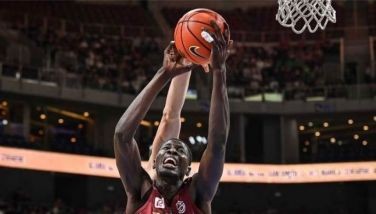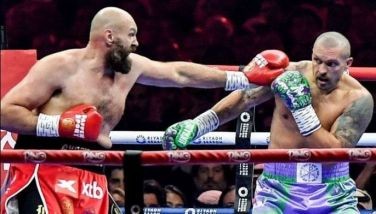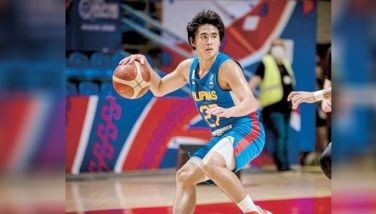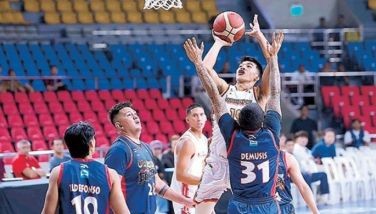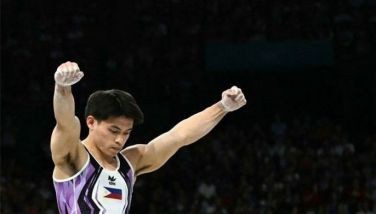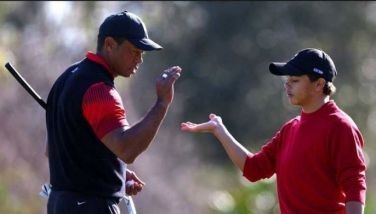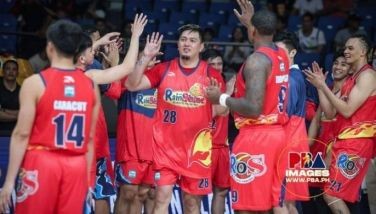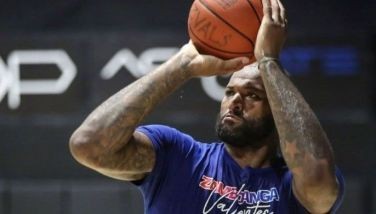The rule of the street
September 5, 2005 | 12:00am
The adidas Asian Streetball Finals was a huge success, despite the inclement weather and weekend traffic at the Araneta Center. The six boys’ teams and five girls’ teams came to play, and the games were all very exciting, causing the hundreds who braved the rains to cheer wildly, especially when the Philippine teams came to play. Visiting teams China, Chinese-Taipei, Hong Kong and Korea sent tough teams who all came out of their own national adidas Streetball tournaments.
The Araneta Coliseum was dressed up specifically for the event. The organizers faced a bit of a delay, as heavy rains made it difficult to bring out the stage and equipment from Gary Valenciano’s concert the night before. Since it would take longer to lay down the wooden floor used by the PBA and other basketball leagues, rubber flooring was laid out for each of the two half-courts. A stage was also set up where one of the courtside sections normally is, with a giant screen reflecting the action back to the live audience.
The tournament was a single-round robin format, officiated by referees from the Basketball Referees Commission (Barecom). This meant each of the boys’ teams would need to play five games in the elimination round and the girls, four games. As of this writing, the Philippines had locked up the boys championship either way. Team Philippines A, bannered by San Beda College and coached by Rene Baena, won its first four games on Saturday, as did Team Philippines B, made up of West Negros’ varsity team, mentored by coach Elvis Atinado. No other team would be able to reach four wins. Interestingly enough, the two local squads would clash in the last game of the elimination round. The champions win a trip to the United States, where they would be able to see adidas’ basketball operations firsthand, and meet some NBA endorsers of the brand. In 2002, the University of the Visayas Green Lancers became only the second Philippine team (and the first boys) to win the Asian championship, and were rewarded with a trip to Orlando, where they met Tracy McGrady (then with the Orlando Magic) and watched a game between the Magic and the Phoenix Suns.
In this year’s girls division, China, with a towering frontline–including two of its four players six feet or taller–swept the eliminations with four wins, followed by a physical Chinese-Taipei squad, whose only loss was to China. The two teams battled to a draw, thanks to a last-second two-pointer, and had to go through a shootout to determine the winner.
Our undersized Philippines girls B team was unable to record a single victory, although they drew the sympathy of the crowd. Team Philippines A was off to a good start, but lost its top scorer to injury against Chinese-Taipei, resulting in two losses that knocked them out of contention.
The opening was impressive, with a rap act followed by the known dancer group the Maneuvers setting the stage for the tournament. Rocker Karl Roy performed a unique version of the national anthem. The Streetball theme was then interpreted using native gongs, with Portland Trailblazers guard Sebastian Telfair declaring the games open.
Many of the rules make streetball unique. First of all, the offensive team has to let the defensive team "check" the ball before every possession. The entry pass is made outside the rainbow, with no interception.
Street basketball rules always reward the defensive team. In every jumpball situation, the defensive team is rewarded with possession, whether it’s a held ball, the ball getting trapped between the rim and backboard, and so on. Officials are strict about players tucking in their uniforms and other courtesies to fellow players and officials. Although coaching was not originally allowed when adidas Streetball first started in the Philippines in 1996, it is now, although only the team captain may call timeouts.
Street basketball has evolved throughout the world, as well. There are "world" championships in various parts of the United States, a wheelchair basketball championship featuring the differently-abled, and even a roller basketball tournament, played on roller blades and started by retired NBA forward Tom LaGarde.
In 1996, the first Philippine team to win a national championship traveled to Budapest for the adidas World Streetball Finals, and witnessed 500 teams playing in the Hungarian national finals. The following year, Baguio’s first-ever national basketball champions were rewarded with a trip to Paris, where they met Kareem Abdul-Jabbar and a young Kobe Bryant.
It is interesting to note how big the tournament has become in other parts of Asia. In the Philippines, aside from the regional tournaments, other pocket events were held to accommodate the many boys and girls who wanted the chance to meet a certified NBA superstar and visit the US. Come to think of it, when we formed our first national basketball team for the Olympics in 1936, there were only two indoor courts in the entire country.
In Asia, basketball was born on the street. And it was born in the Philippines.
Catch this week’s episode of The Basketball Show featuring Sebastian Telfair at the adidas Asian Streetball Finals on IBC-13 at 8:30 p.m.
The Araneta Coliseum was dressed up specifically for the event. The organizers faced a bit of a delay, as heavy rains made it difficult to bring out the stage and equipment from Gary Valenciano’s concert the night before. Since it would take longer to lay down the wooden floor used by the PBA and other basketball leagues, rubber flooring was laid out for each of the two half-courts. A stage was also set up where one of the courtside sections normally is, with a giant screen reflecting the action back to the live audience.
The tournament was a single-round robin format, officiated by referees from the Basketball Referees Commission (Barecom). This meant each of the boys’ teams would need to play five games in the elimination round and the girls, four games. As of this writing, the Philippines had locked up the boys championship either way. Team Philippines A, bannered by San Beda College and coached by Rene Baena, won its first four games on Saturday, as did Team Philippines B, made up of West Negros’ varsity team, mentored by coach Elvis Atinado. No other team would be able to reach four wins. Interestingly enough, the two local squads would clash in the last game of the elimination round. The champions win a trip to the United States, where they would be able to see adidas’ basketball operations firsthand, and meet some NBA endorsers of the brand. In 2002, the University of the Visayas Green Lancers became only the second Philippine team (and the first boys) to win the Asian championship, and were rewarded with a trip to Orlando, where they met Tracy McGrady (then with the Orlando Magic) and watched a game between the Magic and the Phoenix Suns.
In this year’s girls division, China, with a towering frontline–including two of its four players six feet or taller–swept the eliminations with four wins, followed by a physical Chinese-Taipei squad, whose only loss was to China. The two teams battled to a draw, thanks to a last-second two-pointer, and had to go through a shootout to determine the winner.
Our undersized Philippines girls B team was unable to record a single victory, although they drew the sympathy of the crowd. Team Philippines A was off to a good start, but lost its top scorer to injury against Chinese-Taipei, resulting in two losses that knocked them out of contention.
The opening was impressive, with a rap act followed by the known dancer group the Maneuvers setting the stage for the tournament. Rocker Karl Roy performed a unique version of the national anthem. The Streetball theme was then interpreted using native gongs, with Portland Trailblazers guard Sebastian Telfair declaring the games open.
Many of the rules make streetball unique. First of all, the offensive team has to let the defensive team "check" the ball before every possession. The entry pass is made outside the rainbow, with no interception.
Street basketball rules always reward the defensive team. In every jumpball situation, the defensive team is rewarded with possession, whether it’s a held ball, the ball getting trapped between the rim and backboard, and so on. Officials are strict about players tucking in their uniforms and other courtesies to fellow players and officials. Although coaching was not originally allowed when adidas Streetball first started in the Philippines in 1996, it is now, although only the team captain may call timeouts.
Street basketball has evolved throughout the world, as well. There are "world" championships in various parts of the United States, a wheelchair basketball championship featuring the differently-abled, and even a roller basketball tournament, played on roller blades and started by retired NBA forward Tom LaGarde.
In 1996, the first Philippine team to win a national championship traveled to Budapest for the adidas World Streetball Finals, and witnessed 500 teams playing in the Hungarian national finals. The following year, Baguio’s first-ever national basketball champions were rewarded with a trip to Paris, where they met Kareem Abdul-Jabbar and a young Kobe Bryant.
It is interesting to note how big the tournament has become in other parts of Asia. In the Philippines, aside from the regional tournaments, other pocket events were held to accommodate the many boys and girls who wanted the chance to meet a certified NBA superstar and visit the US. Come to think of it, when we formed our first national basketball team for the Olympics in 1936, there were only two indoor courts in the entire country.
In Asia, basketball was born on the street. And it was born in the Philippines.
BrandSpace Articles
<
>
- Latest
- Trending
Trending
Latest
Trending
Latest
Recommended















